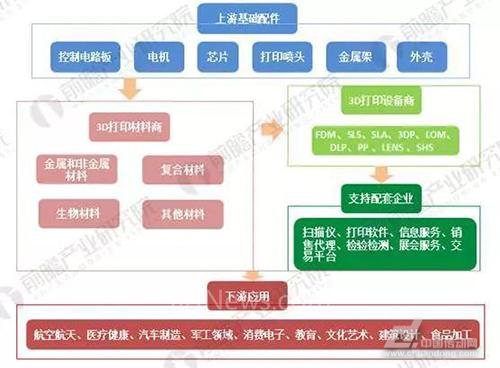[2018 Trend Analysis of 3D Printing Technology: Downstream Applications Mostly for the Automotive Industry] 1,3D Printing Industry Chain Analysis
The industry chain of the entire 3D printing industry can be roughly divided into: the upstream basic accessory industry; the middle 3D printing equipment manufacturing enterprise, the 3D printing material production enterprise and supporting supporting enterprises; the downstream is mainly the major application fields of 3D printing. The 3D printing industry in the usual sense refers mainly to 3D printing equipment, materials and service companies.
At present, 3D printing materials mainly include engineering plastics, photosensitive resins, rubber materials, metal materials, and ceramic materials. In addition, color gypsum materials, artificial bone powder, cell biological raw materials, and sugar and other food materials are also obtained in the 3D printing field. Application.
After nearly 40 years of development, 3D printing has formed a complete industrial chain. Each sector of the industry chain has gathered a group of leading companies. Globally, equipment companies represented by Stratasys and 3D Systems have taken a leading role in the industry chain, and representative equipment companies are generally able to provide materials and print service businesses and have a strong voice.

Chart 1: Analysis of Industry Chain in 3D Printing Industry
2. The scale of the global 3D printing market
3D printing technology can be traced back to the invention of the inkjet printer in 1976. Since the 1980s, the 3D printing industry has received extensive attention at home and abroad, and various 3D printing technologies have also been applied and developed in various industries. At present, it covers many fields such as manufacturing, medical care, education, aerospace, and military.
The global 3D printing market is increasing year by year, and the CAGR of the 3D printing market in 2010-2016 is 24.60%. From US$1.3 billion in 2010 to US$6.06 billion in 2016 (about RMB41.75 billion), the growth rate was 16.54%, a year-on-year decrease of 13.46 percentage points. Accompanied by the rapid growth of 3D printing technology and the penetration of 3D printing technology in various industrial fields. Forward-looking estimate that the global 3D printing industry market in 2017 will exceed US$7 billion. In the next five years, the global 3D printing industry will continue to maintain its momentum of rapid growth.

Chart 2: The scale and growth rate of the global 3D printing market in 2010-2017 (Unit: USD 100 million, %)
3, 3D printing downstream application analysis, the highest proportion of automotive applications
At this stage, 3D printing is mainly used in aerospace, medical, automotive and other fields, and is most widely applied in manufacturing and medical fields. According to the ranking of sales, the global 3D printing output in the machinery, consumer electronics, automotive, aerospace, medical and other industries showed a balanced development. The output value of the machinery industry accounted for 17.5%, which is the main downstream of the 3D printing industry. Application area; followed by consumer electronics output value of 16.6%, ranking second; automotive downstream production value of 16.1,%, second only to consumer electronics applications. In the future, with the development of the electronics and automotive industries, the scale of output value in both areas is expected to increase further.

Chart 3: Analysis of Global 3D Printing Downstream Application Structure (Unit: %)
4, 3D printing material product classification
At this stage, with the advancement of technology and R&D, there are currently more than 300 materials available for 3D printing. As 90% of 3D printer users currently use desktop products, they are like ABS and PLA. The consumption of consumables accounts for more than 50%. At present, the polymer manufacturers also mainly focus on ABS and PLA and nylon materials.
From the perspective of material types, the development of the 3D printing industry depends on the development and application of its materials. Currently, the main materials for the development of the global 3D printing industry are PLA, ABS, StandardResin, PA12, PA2200, PETG, and ClearResin. Its most widely used material is PLA, with an application ratio of 37.1%, followed by ABS accounting for 15.5%.

Exhibit 4: Global 3D Printed Materials Usage in 2016 (Unit: %)
5. Domestic market size of 3D printing materials
With the development of the domestic and international 3D printing industry, 3D printing materials are the main driving force for the development of the industry, and domestic representative enterprises attach importance to the research and development and application of 3D printing materials. In 2012-2016, under the background of the promotion of domestic 3D printing technology, the demand for 3D printing materials in China has continuously increased, with an average annual compound growth rate of 69.62%, which increased from 260 million yuan in 2012 to 2.152 billion yuan in 2016. With the emphasis on the development background of representative enterprises, the forward-looking estimation of China's 3D printed material market size reached 2.376 billion yuan in 2017, and the growth rate has slowed down.

Chart 5: Change in output value of China's 3D printing materials market in 2012-2017 (Unit: 100 million yuan)
All the above data and analysis come from the prospective industry research institute "2018-2023 China 3D printing materials industry development prospects forecast and investment strategy planning report."
Cable Management,cable organizer,wire management,cable cover wall
NINGBO UONICORE ELECTRONICS CO., LTD , https://www.uniconmelectronics.com
